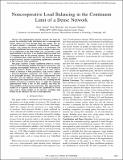Noncooperative load balancing in the continuum limit of a dense network
Author(s)
Altman, Eitan; Menache, Ishai; Ozdaglar, Asuman E.
DownloadAltman-2009-Noncooperative load balancing in the continuum limit of a dense network.pdf (153.6Kb)
PUBLISHER_POLICY
Publisher Policy
Article is made available in accordance with the publisher's policy and may be subject to US copyright law. Please refer to the publisher's site for terms of use.
Terms of use
Metadata
Show full item recordAbstract
In transportation network research, the main approach for predicting traffic distribution due to noncooperative vehicle choices has been through fluid type models. The basic model considers a continuum of infinitesimal "non-atomic" vehicles, each seeking the shortest path to its destination. The resulting equilibrium turns out to be much simpler to characterize in comparison to the finite-vehicle case, yet provides a good approximation to the latter. A less familiar fluid-type model uses a continuum limit for the network topology. The limit network is a continuum plane which inherits its cost structure from the original network, and the corresponding equilibrium is identified as the continuum traffic equilibrium. This paper considers a similar equilibrium notion in a framework of a load balancing problem involving two processors, each requiring non-negligible workload (or "flow") to be handled by network resources. Besides a congestion cost at each resource (which is identical to both processors), each resource induces a processor-dependent connection cost, which is a function of its geographic location. The processors autonomously route their flow onto the different resources, with the objective of minimizing (non-cooperatively) their total cost. Assuming that the number of resources is relatively large, we apply the continuum approximation within a line (or bus) topology and study the Nash equilibria of the processor interaction. This approximation enables us to explicitly characterize the equilibrium in several cases and to obtain insights on its structure, including tight bounds on the efficiency loss due to noncooperation.
Date issued
2009-06Department
Massachusetts Institute of Technology. Department of Electrical Engineering and Computer Science; Massachusetts Institute of Technology. Laboratory for Information and Decision SystemsJournal
IEEE INFOCOM 2009
Publisher
Institute of Electrical and Electronics Engineers
Citation
Altman, E., I. Menache, and A. Ozdaglar. “Noncooperative Load Balancing in the Continuum Limit of a Dense Network.” INFOCOM 2009, IEEE. 2009. 2636-2640. ©2009 Institute of Electrical and Electronics Engineers.
Version: Final published version
ISBN
978-1-4244-3512-8
978-1-4244-3513-5
ISSN
0743-166X